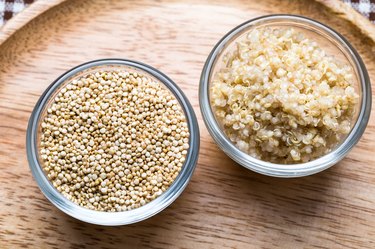
Rich in protein, quinoa is a psuedo-grain that is native to the Andes Mountains. Quinoa's benefits are largely due to its fiber content, as well as the fact that it's gluten free, meaning that it's safe for those with Celiac disease or gluten intolerance.
Tip
Quinoa's fiber content — 5 grams per 1-cup serving — may help improve digestive problems. Dietary fiber keeps you regular, regulates blood sugar and promotes satiety, among other benefits.
Video of the Day
Quinoa Nutrition Facts
Compared to other grains, quinoa's nutrition profile is top-notch. Each 1-cup serving (cooked) provides 222 calories, 8 grams of protein, 3.5 grams of fat, 39 grams of carbohydrate and 5 grams of fiber, according to the USDA.
Video of the Day
Beyond that, though, quinoa's benefits are plentiful. It's a complete protein, meaning that it contains all nine essential amino acids in the proper proportions, notes the Academy of Nutrition and Dietetics. It's also an excellent source of magnesium, zinc, iron and folate.
Read more: Can You Eat Quinoa on a Low-Carb Diet?
On top of being nutritionally sound, quinoa is a gluten-free grain, according to the Gluten Intolerance Group. This makes it suitable for those living with celiac disease. Symptoms of celiac disease, which is an immune reaction to the protein gluten, may include digestive issues, such as diarrhea, bloating, gas, abdominal pain, nausea, vomiting and constipation.
Avoiding gluten can be difficult for some. However, switching to gluten-free grains may help clear up the digestion issues related to celiac disease or gluten intolerance. Keep in mind that quinoa is subject to cross-contamination, so read the label to ensure it has been manufactured in a gluten-free facility.
Fiber Supports Digestive Health
For most people, the link between quinoa and digestion stems from its rich fiber content. Both children and adults are supposed to get between 20 and 30 grams of fiber every day, but most Americans only consume about 15 grams per day, according to Harvard T.H. Chan School of Public Health.
Fiber comes in two forms: soluble and insoluble. The former attracts water and turns to a gel in the stomach, slowing down the digestive process. The latter adds bulk to the stool and helps food pass more quickly through the digestive tract, explains Mount Sinai Hospital.
Quinoa contains both types of fiber, but 78 percent of its fiber content comes from insoluble fiber, according to research published in January 2015 in _Food Chemistry. _In addition to helping with digestion, insoluble fiber may reduce glucose and blood cholesterol levels.
Eating more fiber may also help with specific ailments related to digestion. For example, diverticulitis occurs when a small pouch in the lining of the digestive system, known as diverticula, becomes inflamed or infected, causing severe abdominal pain and changes in bowel habits. A diet rich in fiber may help prevent this condition by softening the stool, which allows it to pass more easily through the colon.
Additionally, those who suffer from irritable bowel syndrome (IBS) often experience constipation, diarrhea, bloating, gas and abdominal pain. Fiber may help alleviate constipation and improve IBS symptoms, according to the International Foundation for Gastrointestinal Disorders. Researchers recommend starting slowly in your quest to eat more fiber and gradually ramping up to the amount consumed.
- USDA FoodData Central: "Quinoa, Cooked"
- Academy of Nutrition and Dietetics: "5 Whole Grains to Keep Your Family Healthy"
- Whole Grains Council: "Quinoa—March Grain of the Month"
- Mayo Clinic: "Celiac Disease"
- Harvard T.H. Chan School of Public Health: "Fiber"
- Mount Sinai Hospital: "Soluble vs. Insoluble Fiber"
- Mayo Clinic: "Diverticulitis"
- International Foundation for Gastrointestinal Disorder: "Dietary Fiber"
- Gluten Intolerance Group: "Gluten-Free Grains"
- Food Chemistry: "Quinoa (Chenopodium Quinoa W.) and Amaranth (Amaranthus Caudatus L.) Provide Dietary Fibres High in Pectic Substances and Xyloglucans"